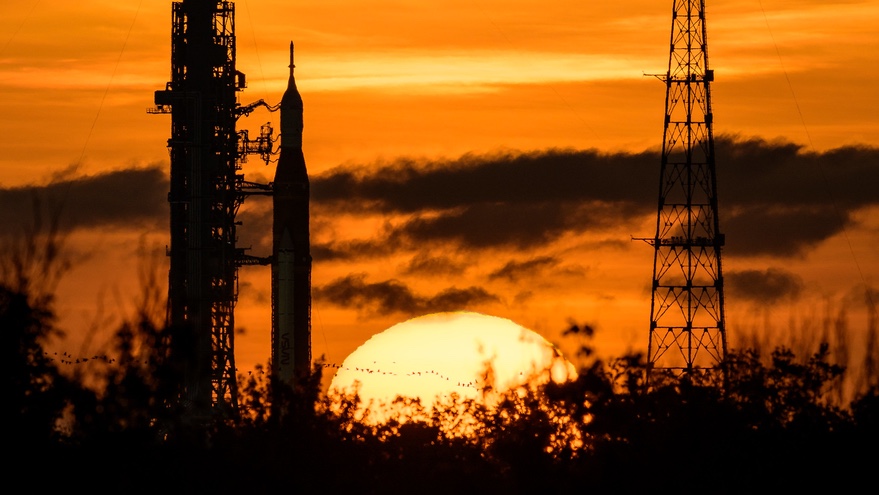KENNEDY SPACE CENTER, Fla. — NASA has restarted the countdown for the first launch of its Space Launch System vehicle and Orion spacecraft after concluding a faulty sensor caused the first attempt to scrub earlier in the week.
Countdown clocks started ticking down after a mission management team meeting Sept. 1, setting up a launch attempt at 2:17 p.m. Eastern at the beginning of a two-hour window. This will be the second attempt to launch the SLS after controllers scrubbed the initial attempt Aug. 29.
At a briefing late Sept. 1, officials said they believe the primary issue that caused the first scrub, a higher-than-expected temperature in one of four RS-25 engines in the core stage after chilling them with liquid hydrogen, was an artifact of a faulty sensor in that engine and not a problem cooling the engine.
“Yes, we know we had a bad sensor,” said John Honeycutt, NASA SLS program manager, arguing the sensor’s anomalously high temperature reading did not match the physics of the flow of liquid hydrogen through the engine. “We’ve had time to go back and look at the data and compare many sources of data, and do some independent analysis that confirmed it’s a bad sensor and we’re getting good quality propellant through the engine.”
John Blevins, SLS chief engineer at NASA, said the sensor is there for engineering purposes only, as one means to measure the engine chilldown, and is not used by the vehicle’s flight computer. Because of that, the data from the faulty sensor does not need to be “masked” or hidden from the flight computer for the countdown to proceed. “We do not need the sensor for flight.”
Asked if controllers will simply ignore the data from that sensor, Blevins responded, “Yes, we will.” Because that chilldown is being moved up somewhat earlier in the countdown, he said there will be sufficient time for controllers to verify by other means that liquid hydrogen is flowing through the engines enough to cool them to the proper temperatures.
Mike Sarafin, NASA Artemis mission manager, said controllers ran out of time during the first launch attempt to confirm the engine chilldown was properly working despite the bad sensor. “We ran into other issues” earlier in the countdown, he said, such as a hydrogen leak in a ground umbilical and a vent valve that was not working.
“We were off the script in terms of the normal tanking operation,” he said. “One of the worst things you can do when you find yourself in a hazardous condition is just go even further off-script.” With “20/20 hindsight” it’s now clear those sensors are not the best means of measuring the status of the engine chilldown, he addded.
“We have a great plan moving forward. We understand the risk posture associated with the getting the engines thermally conditioned,” he said. “The team was asked today, very specifically, ‘Are you ready to go load the vehicle with this earlier tanking and earlier bleed flow operation?’ and the answer was absolutely yes.”
Workers also used the time since the first scrub to address other issues, including the hydrogen leak seen in the tail service mast umbilical earlier in the countdown. Charlie Blackwell-Thompson, Artemis launch director, said technicians used the experience from a similar issue during an earlier wet dress rehearsal to fix the leak. The issue, she said, appeared to be a pressure sensor that gotten loose, and workers replaced its seal and retorqued it.
“We believe that is, most likely, the leak source,” she said, as other potential sources appeared to be normal. “Until you hit it with cryo, you don’t know for sure.”
Weather forecasts for the launch are more favorable, with a 60% chance of acceptable weather for the Sept. 3 launch window and 70% if the launch is rescheduled for Sept. 5. There may be times during the window when weather is no-go because of clouds or showers, said Melody Lovin, weather officer with the Space Force’s Space Launch Delta 45, “but the bottom line is that I don’t expect weather to be a showstopper.”
Launch managers separately ruled out a Sept. 4 launch attempt, which would have only been an option if NASA postponed the Sept. 3 launch before beginning tanking of the rocket. An analysis showed that, if the SLS upper stage underperformed during its translunar injection burn on a launch that day, Orion could be placed on a trajectory that increased eclipses that would have caused problems for the solar-powered spacecraft. A launch is possible on Sept. 6, the last day of the current launch period, but only in a short window at the end of the day.
Sarafin said that, with a successful launch Sept. 3, the Artemis 3 mission would last approximately 37 days, with a splashdown off the California coast Oct. 11.
